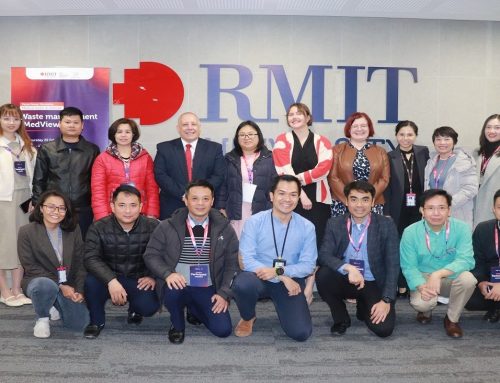Humanitarian logistics, humanitarian operations management, humanitarian supply chain management – these are not only topics that the HUMLOG Institute are working with, but also themes that are becoming more and more popular at various conferences. I have myself attended several conferences and have had the joy to sit in at many presentations serving the most recent finding from research projects around the globe. However, many of these conferences are focused on operations management and supply chain management, which I realise can give a skewed picture about how relevant or popular humanitarian issues seem to be in academia. I am working in the HUMLOG project on Cascading innovation upstream the supply chain (CAIUS), in which we study public procurement for innovation and emergencies in Finland, and decided to go to a public management conference – the Annual Conference of the International Research Society of Public Management (IRSPM) in Hong Kong in April this year – to see what’s going on in that field. In this blog post, I elaborate on the discussions going on there, and compare them to the Annual Conference of the Production and Operations Management Society (POMS), which took place in the beginning of May.
First of all, I noticed that the healthcare area has earned a special place in public management, just as it has in operations management – both societies have established special interest groups or colleges around this area. Secondly, purchasing or procurement have panels or tracks in both conferences, and being involved in the CAIUS project these presentations were of interest to me. Turning to the Humanitarian area though the difference between the conferences are much larger: at POMS the Humanitarian Crisis and Operations Management track was, for what I recall, the second largest among the college tracks this year, while the Humanitarian sector did not have any panel area of its own at the IRSPM conference. However, the ”Sectoral challenges”-area included several panels that could be argued to invite presentations related to humanitarian logistics and supply chain management, for example ”Emergency Services Management: The Case for Bridging the Theory-Practice Divide”. There were in addition a couple of panels related to decease outbreak management, but they were cancelled.
To get a better overview of the content of these two conferences, I ran a word frequency query on the schedules in the analysis software NVivo and got the following results (although they are skewed due to the fact that the POMS program contained short abstracts in addition to the headlines of the presentations, and some words do not come from the content of the presentations but from the layout of the schedules):
|
IRSPM |
POMS |
||
|
Word |
Count |
Word |
Count |
|
public |
309 |
university |
2804 |
|
management |
165 |
professor |
2684 |
|
chair |
162 |
united |
2418 |
|
polyu |
134 |
states |
2249 |
|
performance |
95 |
065 |
1555 |
|
service |
74 |
student |
931 |
|
2016 |
68 |
assistant |
917 |
|
local |
66 |
management |
852 |
|
governance |
63 |
supply |
797 |
|
case |
55 |
associate |
751 |
|
sector |
54 |
chain |
585 |
|
research |
52 |
operations |
584 |
|
government |
51 |
brazil |
504 |
|
leadership |
50 |
technology |
501 |
|
van |
49 |
study |
482 |
|
hong |
45 |
session |
454 |
|
international |
44 |
chair |
442 |
|
kong |
42 |
track |
441 |
|
policy |
42 |
model |
387 |
|
china |
38 |
institute |
342 |
|
april |
37 |
performance |
338 |
|
13th |
35 |
product |
334 |
|
15th |
35 |
data |
325 |
|
one |
35 |
service |
314 |
|
society |
35 |
china |
312 |
|
20th |
34 |
state |
306 |
|
abstract |
34 |
impact |
297 |
|
conference |
34 |
using |
296 |
|
ordo |
34 |
research |
268 |
These results give some hints about the popularity of certain topics or concepts in the conferences, and it is interesting to see that there are some commonalities, such as ‘China’, ‘performance’ and ‘service’. There are also some expected differences, such as focus on ‘public’ and ‘governance’ in IRSPM, and ‘operations’ and ‘supply’ in POMS. Since humanitarian doesn’t show up in the top for either conference, I looked further into the frequency of words used in the program, and identified the following frequencies of mentioning of relevant words:
|
Word |
IRSPM |
POMS |
|
Conflict |
3 |
4 |
|
Crisis |
6 |
30 |
|
Disaster |
1 |
71 |
|
Emergency |
6 |
70 |
|
Humanitarian |
0 |
141 |
|
Nonprofit |
4 |
6 |
|
Public |
309 |
51 |
|
Relief |
0 |
36 |
|
Resilience |
1 |
26 |
|
Response |
1 |
68 |
|
Risk |
9 |
149 |
|
Uncertainty |
2 |
67 |
My conclusions from this are that the public management discipline does not seem to pay much attention to the humanitarian area and disaster management, at least not compared to the Production and Operations Management society, which in turn seems to be more interested in private or humanitarian organizations (‘public’ is mentioned ‘only’ 51 times in the POMS program). This is interesting, and maybe worrying, considering that public organisations might want to ensure their ability to operate and fulfil their mandates to the people also in crises and emergency situations.
Whatever interpretations these numbers can entail, they do not necessarily tell the whole story of the content. I attended a few presentations at the IRSPM conference where the presenters talked about crisis management and found them really interesting. George Carayannopoulos and Allan McConnell from the University of Sydney had written a paper with the title ‘Bringing Lessons from Crisis Management into the Realm of Wicked Problems’ in which they discuss whether governments can learn about the management of wicked problems from crisis management. Gregg van Ryzin, Norma Riccucci and Huafang Li from Rutgers University-Newark presented their work ‘Gender representation and the coproduction of emergency preparedness: An experimental study and replication’. They had made an experiment survey describing different scenarios in which respondents’ willingness to donate or participate as volunteers depending on the race and gender of the person approaching them was measured. In addition to these two examples, there were also a few other presentations that I was unable to attend, so I won’t go into detail about those.
What do we learn from this? My main conclusion is that there is room for interdisciplinary work, or at least for bridging the gap between the disciplines regarding how humanitarian and crisis management is studied in the areas. Especially, there is room to explore crisis and emergency management in the public, and for example how the public operate together with humanitarian organisations, from both operations, supply chain and public management perspectives. Although my intention is not to be self-righteous, I think the CAIUS project is a good step in this direction, and I hope to see more initiatives of this kind in the future.
– Isabell




